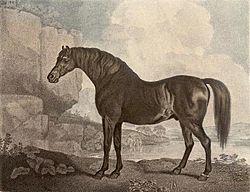Marske (horse) facts for kids
Marske (born 1750 – died July 1779) was a famous Thoroughbred racehorse. He is most well-known for being the father of the amazing horse named Eclipse.
Quick facts for kids Marske |
|
|---|---|

Marske
|
|
| Sire | Squirt |
| Grandsire | Bartlett's Childers |
| Dam | The Rugby or Ruby Mare |
| Damsire | Blacklegs |
| Sex | Stallion |
| Foaled | 1750 |
| Country | Great Britain |
| Colour | Brown |
| Breeder | John Hutton |
| Owner | Prince William, Duke of Cumberland, William Wildman, Willoughby Bertie, 4th Earl of Abingdon |
| Record | 5: 2-0-1 |
| Major wins | |
| Jockey Club Plate (1754) | |
| Awards | |
| Leading sire in Great Britain and Ireland (1775, 1776) |
|
| Last updated on August 25, 2007 | |
Contents
Marske's Early Life and Racing Career
Marske was born in 1750 at Marske Hall in Yorkshire, England. His breeder was John Hutton. When Marske was just a foal, he was traded to Prince William, Duke of Cumberland. The Duke was a very important person and also owned another famous horse named Herod.
Marske started his racing career in 1754. He won the Jockey Club Plate race at Newmarket. This was a big win for him. He also won a special match race against a horse named Ginger.
In 1755, Marske raced again at Newmarket and finished third. After that, he didn't race for a while. He returned to racing in 1756 but lost two important races against a horse named Snap. After these races, Marske stopped racing and began his career as a breeding horse.
Marske's Breeding Career and Famous Offspring
After his racing days, Marske went to the Duke of Cumberland's farm to become a breeding horse, also known as a stallion. When the Duke passed away in 1765, Marske was sold at an auction for a very small amount of money to a farmer. At this time, Marske was not considered a very special horse.
The farmer charged a low fee for Marske to breed with other horses. Later, Marske was sold again to William Wildman for 20 guineas. His breeding fee slowly increased over time.
The Rise of Eclipse
Marske's popularity changed dramatically when his son, Eclipse, started winning every race he entered. Eclipse was an amazing racehorse who was never beaten. Because Eclipse was so successful, everyone wanted their horses to be bred with Marske.
Marske was then sold for a huge profit of 1,000 guineas to Willoughby Bertie, 4th Earl of Abingdon. The Earl raised Marske's breeding fee to 100 guineas, which was a very high price back then!
Marske's Successful Children
Marske spent 22 years at the Earl of Abingdon's farm in Oxfordshire. During this time, he became a very successful father to many racehorses. He sired 154 winners in total.
Here are some of his most famous children:
- Eclipse: Born in 1764, this chestnut male horse was undefeated in all 18 of his races. He became even more famous as a breeding horse. Today, it's believed that about 95% of all Thoroughbred horses are related to Eclipse!
- Young Marske: Born in 1771, this bay male horse produced many good breeding mares. He was also the father of Ruler, who won the St. Leger race.
- Hephestion: Born in 1771, this male horse won the Jockey Club Plate and Craven Stakes.
- Shark: Born in 1771, this brown male horse was a top racehorse. He won 19 out of 29 races and earned a lot of money. He later went to Virginia in America and had several good breeding mares there.
- Pontac: This horse was the father of Sir Thomas, who won the Derby race.
- Masquerade: Born in 1771, this female horse was a very good race mare.
Marske's children earned a lot of money in prize money, showing how successful he was as a breeding horse. He died in July 1779, leaving behind a great legacy in the world of horse racing.

